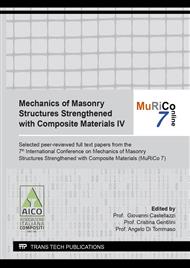[1]
F. Bencardino, C. Carloni, A. Condello, F. Focacci, A. Napoli, and R. Realfonzo. Flexural behaviour of rc members strengthened with FRCM: State-of-the-art and predictive formulas. Composites Part B: Engineering, 148:132–148, (2018).
DOI: 10.1016/j.compositesb.2018.04.051
Google Scholar
[2]
P. Meriggi, S. De Santis, S. Fares, and G. de Felice. Design of the shear strengthening of masonry walls with fabric reinforced cementitious matrix. Construction and Building Materials, 279:122452, (2021).
DOI: 10.1016/j.conbuildmat.2021.122452
Google Scholar
[3]
F. Faleschini, M.A. Zanini, L. Hofer, and C. Pellegrino. Experimental behavior of reinforced concrete columns confined with carbon-FRCM composites. Construction and Building Materials, 243:118296, (2020).
DOI: 10.1016/j.conbuildmat.2020.118296
Google Scholar
[4]
M.A. Aiello, F. Bencardino, A. Cascardi, T. D'Antino, M. Fagone, I. Frana, L. La Mendola, G.P. Lignola, C. Mazzotti, F. Micelli, et al. Masonry columns confined with fabric reinforced cementitious matrix (FRCM) systems: A round robin test. Construction and Building Materials, 298:123816, (2021).
DOI: 10.1016/j.conbuildmat.2021.123816
Google Scholar
[5]
P. Colombi and T. D'Antino. Analytical assessment of the stress-transfer mechanism in FRCM composites. Composite Structures, 220:961–970, (2019).
DOI: 10.1016/j.compstruct.2019.03.074
Google Scholar
[6]
F. Wang, N. Kyriakides, C. Chrysostomou, E. Eleftheriou, R. Votsis, and R. Illampas. Experimental research on bond behaviour of fabric reinforced cementitious matrix composites for retrofitting masonry walls. International Journal of Concrete Structures and Materials, 15(1):1–17, (2021).
DOI: 10.1186/s40069-021-00460-1
Google Scholar
[7]
CSLP. Italian guideline for the identification, qualification and acceptance control of fibre reinforced cementitious matrix (FRCM) used for the structural consolidation of existing constructions, (2018).
Google Scholar
[8]
ICC AC434-13. Acceptance criteria for masonry and concrete strengthening using fiberreinforced cementitious matrix (FRCM) composite systems. ICC-Evaluation Service, Whittier, CA, (2013).
Google Scholar
[9]
A. Monaco, G. Minafò, J. D'Anna, M.C. Oddo, and L. La Mendola. Constitutive numerical model of frcm strips under traction. Frontiers in Built Environment, 6:60, (2020).
DOI: 10.3389/fbuil.2020.00060
Google Scholar
[10]
F. Nerilli, S. Marfia, and E. Sacco. Micromechanical modeling of the constitutive response of frcm composites. Construction and Building Materials, 236:117539, (2020).
DOI: 10.1016/j.conbuildmat.2019.117539
Google Scholar
[11]
E. Grande and G. Milani. Procedure for the numerical characterization of the local bond behavior of FRCM. Composite Structures, 258:113404, (2021).
DOI: 10.1016/j.compstruct.2020.113404
Google Scholar
[12]
G. Misseri, L. Rovero, and S. Galassi. Analytical modelling bond behaviour of polybenzoxazole (PBO) and glass fibre reinforced cementitious matrix (FRCM) systems coupled with cement and gypsum matrixes: Effect of the cohesive material law (CML) shape. Composites Part B: Engineering, 223:109090, (2021).
DOI: 10.1016/j.compositesb.2021.109090
Google Scholar
[13]
M.C. Oddo, G. Minafò, and L. La Mendola. Constitutive models for the tensile behaviour of TRM materials: Literature review and experimental verification. Materials, 14(3):700, (2021).
DOI: 10.3390/ma14030700
Google Scholar
[14]
G. Castori, M. Corradi, and E. Sperazini. Full size testing and detailed micro-modeling of the inplane behavior of frcm–reinforced masonry. Construction and Building Materials, 299:124276, (2021).
DOI: 10.1016/j.conbuildmat.2021.124276
Google Scholar
[15]
S. De Santis, G. de Felice, and F. Roscini. Retrofitting of masonry vaults by basalt textilereinforced mortar overlays. International Journal of Architectural Heritage, 13(7):1061–1077, (2019).
DOI: 10.1080/15583058.2019.1597947
Google Scholar
[16]
F. McKenna, G. L. Fenves, M. H Scott, et al. Open system for earthquake engineering simulation. University of California, Berkeley, CA, (2000).
Google Scholar
[17]
G. Mazzucco, T. D'Antino, C. Pellegrino, and V. Salomoni. Three-dimensional finite element modeling of inorganic-matrix composite materials using a mesoscale approach. Composites Part B: Engineering, 143:75–85, (2018).
DOI: 10.1016/j.compositesb.2017.12.057
Google Scholar
[18]
N. Mordà and A. Mancini. Norme tecniche per le costruzioni (ntc 2018) d. min. infrastrutture e trasporti 17 gennaio 2018, (2018).
Google Scholar
[19]
E. Grande and G. Milani. Interface modeling approach for the study of the bond behavior of FRCM strengthening systems. Composites Part B: Engineering, 141:221–233, (2018).
DOI: 10.1016/j.compositesb.2017.12.052
Google Scholar


